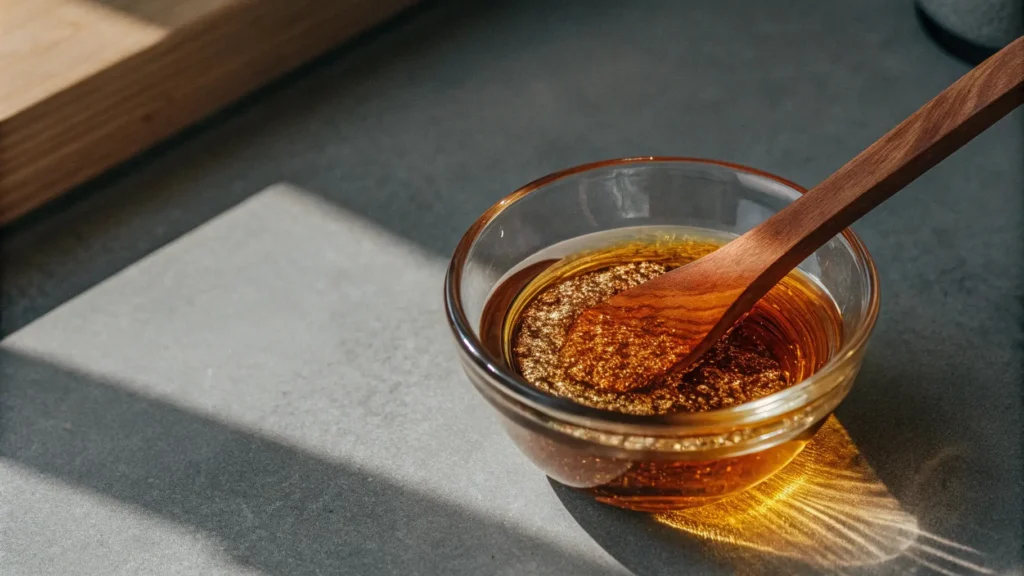Best Substitute for Sesame Oil: 7 Easy Alternatives for Any Dish
Are you searching for a sesame oil substitute for your cooking? With many options, picking the right one can be tough. Sesame oil is loved for its nutty taste, a key part in about 50% of Asian dishes. If you’re looking for a substitute because of allergies, dietary needs, or just ran out, finding one can be hard.

You can use different oils as a sesame oil substitute, like olive, grapeseed, and avocado oil. These oils can bring flavor and texture to your meals. When picking a substitute, think about the oil’s taste and smoke point. This helps you find the best sesame oil substitute for your cooking.
Table of Contents
Key Takeaways
- There are several alternatives to sesame oil, including olive oil, grapeseed oil, and avocado oil.
- Sesame oil is celebrated for its nutty flavor, which is a key characteristic in approximately 50% of Asian cuisines.
- When looking for a substitute for sesame oil, consider the flavor profile and smoke point of the oil.
- Olive oil, grapeseed oil, and avocado oil can be used as a substitute for sesame oil in many dishes.
- Using a substitute for sesame oil can add flavor and texture to your dishes.
- A sesame oil substitute can be used in a variety of cooking methods, including stir-frying and roasting.
Understanding Sesame Oil and Its Unique Properties
Sesame oil is a key ingredient in many Asian dishes. It’s used in Chinese, Japanese, Korean, and Indian cooking. It adds flavor to stir-fries and dressings. When searching for a sesame oil substitute, knowing the difference between regular and toasted sesame oil is important.
Regular sesame oil comes from raw sesame seeds. Toasted sesame oil, on the other hand, is made from toasted seeds. This gives it a darker color and a richer taste.
Finding a toasted sesame oil substitute can be hard because of its distinct taste. But, knowing what sesame oil is made of helps. It’s full of antioxidants like sesamol and sesaminol. These protect cells from damage.
Regular vs. Toasted Sesame Oil
Regular sesame oil works well for sautéing because it has a medium smoke point. But, it’s not good for very high heat. Toasted sesame oil, with its low smoke point, is best used at the end to add flavor. It can burn easily.
Why You Might Need a Substitute
Some people might feel bloated or have diarrhea after eating a lot of sesame oil. Also, sesame allergies are common. For those with allergies, finding a good sesame oil substitute is key.
| Type of Sesame Oil | Smoke Point | Usage |
|---|---|---|
| Regular Sesame Oil | Medium | Sautéing, cooking |
| Toasted Sesame Oil | Low | Final flavor addition |
Perfect Substitute for Sesame Oil in Asian Cooking
Finding the right substitute for sesame oil in Asian cooking can be tough. There are many oils to choose from, each with its own taste and uses. Sesame oil is special in Asian dishes because of its nutty flavor. But, if you need a substitute, peanut oil is a good pick. It has a mild nutty taste and can handle high heat up to 440°F.
Other good choices for a substitute for sesame oil in Asian cooking are:
- Peanut oil: with its high smoke point and mild nutty flavor
- Avocado oil: with its high smoke point and mild, buttery flavor
- Sunflower oil: with its natural flavor and high smoke point
These oils work well in many Asian dishes like stir-fries, noodles, and soups. They add flavor and aroma. By picking the right substitute for sesame oil in Asian cooking, you can make tasty and authentic dishes. These dishes are sure to wow your guests.
How to Choose the Right Oil Alternative
When searching for a sesame oil substitute, think about the smoke point, taste, and oil properties. You might ask, can i use sesame oil instead of olive oil? The answer depends on your recipe and taste preferences. Let’s look at the important factors to consider.
A good sesame oil substitute should taste similar and have the same smoke point. For example, perilla oil tastes like sesame oil and can be used the same way. Avocado oil, on the other hand, has a high smoke point and is great for cooking at high temperatures.
- Smoke point: Choose an oil with a high smoke point for high-heat cooking.
- Flavor profile: Select an oil with a similar flavor profile to sesame oil, such as perilla or walnut oil.
- Oil properties: Consider the oil’s viscosity, texture, and nutritional content.
By looking at these factors, you can pick the best sesame oil substitute for your dish. This way, you’ll enjoy a tasty and healthy meal.
Olive Oil as a Healthy Sesame Oil Alternative
Looking for a substitute for sesame oil? Consider olive oil for its health perks. It’s packed with monounsaturated fats and antioxidants, making it a top pick for a healthier choice.
Here are some key health benefits of olive oil:
- It helps lower heart disease risk thanks to its monounsaturated fats.
- Its antioxidants protect cells from damage.
- It also supports brain health and may lower the risk of neurodegenerative diseases.
Olive oil is great for cooking, dressings, and marinades. As a substitute for sesame oil, it brings a rich flavor to your dishes. Its high smoke point makes it perfect for high-heat cooking, adding to its kitchen versatility.
In summary, olive oil is a fantastic choice for a healthy substitute for sesame oil. Its health benefits and cooking versatility make it ideal for any meal.
Plant-Based Alternatives for Sesame Oil
Looking for a toasted sesame oil substitute? Plant-based options can offer similar tastes and health perks. Perilla oil, walnut oil, and grapeseed oil are top picks. They’re tasty and packed with nutrients, making them perfect for cooking.
Some popular plant-based alternatives include:
- Perilla oil, known for its nutty and earthy flavor, similar to toasted sesame oil
- Walnut oil, with its mild and nutty essence, ideal for flavoring finished dishes
- Grapeseed oil, characterized by its neutral flavor and high smoke point, making it suitable for various cooking methods
These oils work well in many dishes, like stir-fries and salads. They’re great substitutes for sesame oil in recipes. Using them in your cooking lets you enjoy plant-based benefits while keeping the flavors you love.
These alternatives also have health perks. They help reduce oil use and offer fewer calories and less processed fat. Perilla oil, walnut oil, and grapeseed oil are excellent choices for a sesame oil substitute.
| Oil | Flavor Profile | Smoke Point |
|---|---|---|
| Perilla oil | Nutty and earthy | Medium |
| Walnut oil | Mild and nutty | Low |
| Grapeseed oil | Neutral | High |
Creating Sesame Oil Flavor at Home
To make a tasty sesame oil at home, try making a homemade version. You can toast sesame seeds and mix them with a neutral oil. You’ll need ¼ cup of raw white hulled sesame seeds and 1 cup of oil like grapeseed or avocado.
First, toast the sesame seeds for 12 to 15 minutes until they’re golden. Then, blend them with the neutral oil until it’s smooth. Let it cool, then strain it to get the oil. This homemade oil is great as a substitute in many dishes.
Here are some tips for making homemade sesame oil: * Use a high-speed blender for a smooth mix * Strain the mix through a sieve with a thin cloth, like muslin * Keep the homemade oil in the fridge to make it last longer * Use the sesame seed pulp in dishes like granola to add flavor and reduce waste

By following these steps, you can make a delicious homemade sesame oil. It’s a great alternative to store-bought oil. You can use it in many dishes to add flavor and depth.
Best Substitutes for Different Cooking Methods
Finding a substitute for sesame oil depends on the cooking method. Each method needs a specific substitute. For stir-frying, use oils like peanut oil or sunflower oil because they have a high smoke point.
For dressings or marinades, choose oils with a milder taste. Grapeseed oil or olive oil works well here. Deep-frying calls for oils with an even higher smoke point, such as algae oil or avocado oil.
- Peanut oil: great for stir-frying and deep-frying
- Sunflower oil: suitable for high-heat cooking and dressings
- Grapeseed oil: mild flavor, perfect for dressings and marinades
- Algae oil: high smoke point, ideal for deep-frying
Always pick a substitute that fits your dish’s flavors and the cooking method. A bit of experimentation will help you find the best sesame oil substitute for your cooking.
Common Mistakes to Avoid When Substituting Oils
When you’re looking for a sesame oil substitute, it’s key to know the unique traits of different oils. A big mistake is not thinking about the oil’s smoke point. Oils have different smoke points, and using one that’s too low for high-heat cooking can ruin the taste and might even be harmful.
Another mistake is not matching the oil’s flavor to the dish. Sesame oil has a unique nutty taste. Swapping it with an oil that tastes strong can change the dish’s flavor. For instance, peanut oil has a mild nutty taste and works well as a sesame oil substitute in some recipes.
Here are some common mistakes to avoid when substituting oils:
- Not considering the smoke point of the oil
- Not considering the flavor profile of the oil
- Not using the correct substitution ratio

By steering clear of these mistakes, you can find the best sesame oil substitute for your recipe. This way, your dish will be delicious and safe to eat.
Conclusion: Making the Most of Your Sesame Oil Alternatives
Discovering substitutes for sesame oil can really boost your cooking. You can find oils that match sesame oil’s nutty taste, high smoke point, or health perks. This article has shown you many options, from olive oil to perilla oil, to help you choose.
Knowing what each oil does can help you use them in your favorite dishes. You can try new things or stick to what you know. Just remember to think about smoke points, tastes, and how the oil fits into your recipe. With a bit of creativity, you can still get great results without sesame oil.
Now, it’s time to try out these sesame oil substitutes. Start new recipes, mix bold flavors, and use your kitchen to its fullest. Your taste buds are ready for an exciting adventure!
FAQ
What are some easy alternatives for sesame oil?
Easy alternatives include olive oil, peanut oil, and vegetable oil. You can also make your own sesame oil substitute.
What is the difference between regular and toasted sesame oil?
Regular sesame oil tastes milder. Toasted sesame oil has a stronger, nutty flavor. Choose based on your dish’s taste.
What is the best sesame oil substitute for Asian cooking?
For Asian dishes, try peanut oil, vegetable oil, or a homemade sesame oil flavor.
What should I consider when choosing a sesame oil alternative?
Think about the smoke point, flavor, and oil properties. This ensures the best fit for your dish.
Is olive oil a healthy substitute for sesame oil?
Yes, olive oil is a healthy choice. It’s full of good fats and antioxidants.
What are some plant-based alternatives to sesame oil?
Try perilla oil, walnut oil, or grapeseed oil as plant-based options.
Can I make my own sesame oil flavor at home?
Yes, you can. Use toasted sesame seeds and vegetable oil to make your own flavor.
What are the best substitutes for sesame oil in different cooking methods?
The right substitute depends on the cooking method. For stir-frying, dressings, or deep-frying, choose wisely.
What are some common mistakes to avoid when substituting oils?
Don’t forget to check the smoke point, flavor, and oil properties. This avoids common mistakes.







